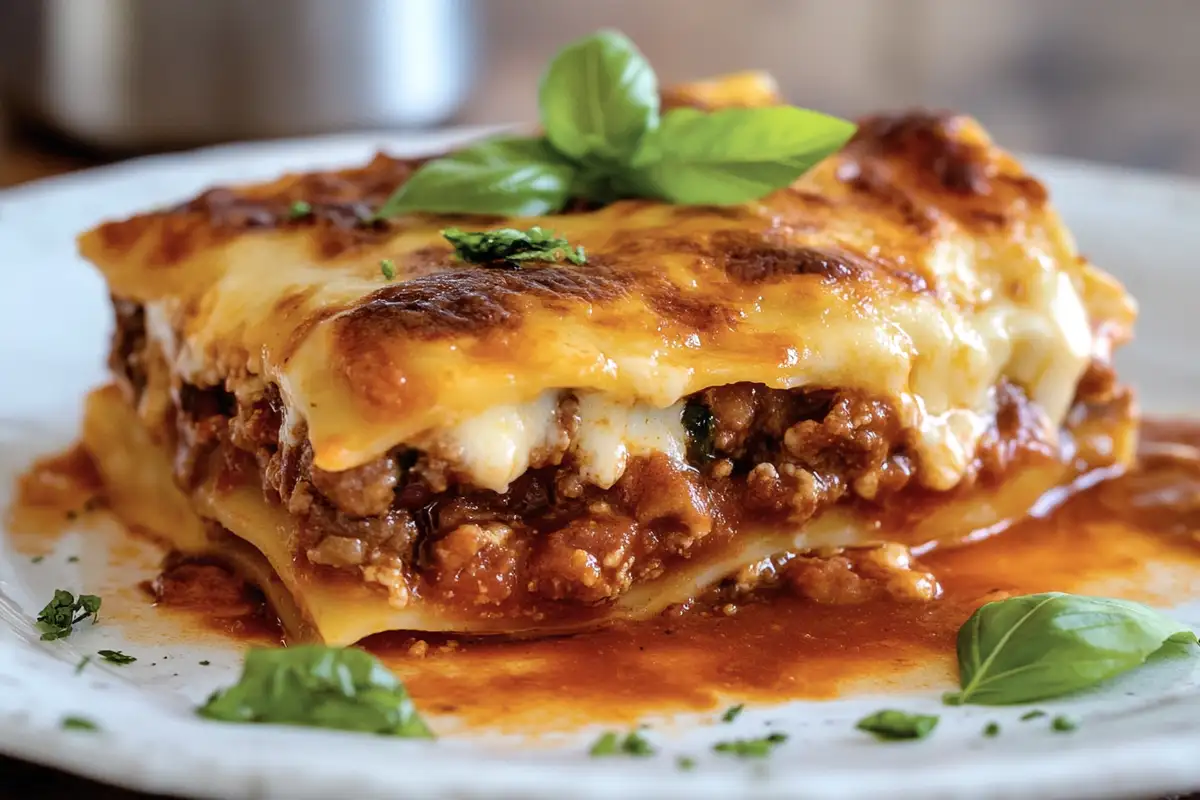Introduction To Lasagna Bolognese With Bechamel Sauce Recipe
A few dishes embody the essence of comfort food, and one of the best is lasagna Bolognese with Bechamel sauce. With its hearty Bolognese and creamy Bechamel sauces, this iconic Italian recipe delivers a perfect symphony of flavors and textures. Whether hosting a family dinner or embarking on a culinary project for the weekend, the patience required to master this layered pasta delight will bring a sense of calm and focus to your cooking. In this article, you’ll explore everything—from crafting authentic sauces to assembling and baking the perfect lasagna. The process includes preparing the rich Bolognese and silky Bechamel sauces, selecting ideal pasta sheets, layering the dish, and baking it to golden perfection. Let’s dive in!
Table of Contents
A Classic Italian Delight
Importance of Authentic Ingredients
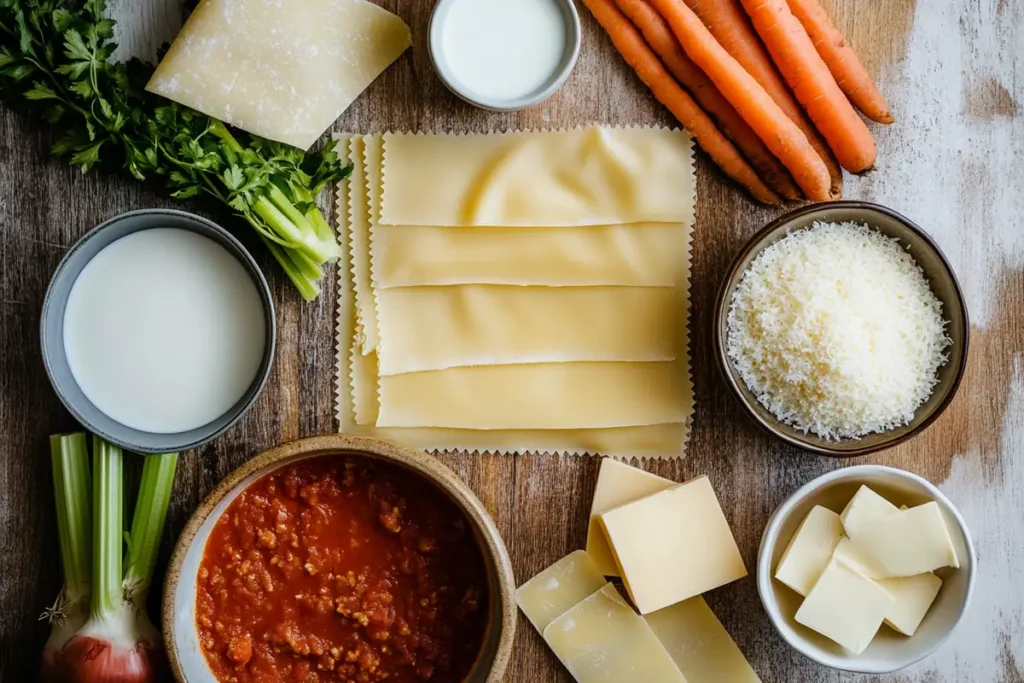
When it comes to lasagna Bolognese with Bechamel sauce, authenticity matters. Using traditional components like fresh pasta sheets, slow-cooked Bolognese sauce, and silky Bechamel sauce ensures each bite is as rich and satisfying as it was meant to be. The unique sense of accomplishment and pride that comes from using these authentic ingredients is what truly elevates this dish.
The Role of Fresh Ingredients
Fresh ingredients are the backbone of Italian cuisine. Tomatoes at peak ripeness, quality olive oil, and fresh basil deliver unmatched flavors. The meat selections, too, are vital for a robust Bolognese. When paired with pancetta, ground beef and pork create a depth of flavor that can’t be replicated with shortcuts. This emphasis on fresh, quality ingredients is what sets Italian cuisine apart.
Why Store-Bought Options Fall Short
Grabbing a jar of pre-made sauce or dried pasta is tempting, but the flavor difference is night and day. Store-bought options often lack the complexity and freshness of homemade components, so making your sauces is rewarding.
A Brief Cultural Insight
Italy, especially the Emilia-Romagna region, treasures its lasagna recipes. It’s not just food—it’s a symbol of tradition and pride. In Bologna, the heart of the dish’s origin, every family has its own version. Although variations exist, the core remains the same: hearty meat sauce, creamy white sauce, and layers of pasta. This dish is a testament to the rich culinary heritage of Italy and the importance of family and tradition in Italian culture.
Link Out: Explore this Traditional Italian Lasagna Recipe for a deep dive into Italy’s regional lasagna traditions.
Understanding the Components
What is Bolognese Sauce?
Bolognese sauce, or ragù alla Bolognese, is the star of lasagna Bolognese with Bechamel sauce Recipe. This slow-cooked meat sauce combines robust flavors with a velvety texture, making it a hallmark of Italian cuisine.
Origins and History
The sauce hails from Bologna, a city in Italy’s Emilia-Romagna region. Its origins trace back to the late 18th century, though the recipe has evolved. Traditionally, it’s served with tagliatelle, but lasagna showcases its richness in layered perfection.
Key Ingredients of Authentic Bolognese
An authentic Bolognese sauce starts with a sofrito—finely chopped onions, carrots, and celery. These aromatics are sautéed in olive oil or butter, forming the base. High-quality ground beef, pork, and pancetta are added, followed by milk or cream to soften the meat’s flavor. Finally, crushed tomatoes and a splash of red wine create a simmered sauce for hours.
What is Bechamel Sauce?
Bechamel, also known as “white sauce,” is the glue that holds lasagna layers together. Its creamy, smooth texture contrasts perfectly with the hearty Bolognese sauce.
Culinary Background
Bechamel sauce originated in France but quickly became a staple in Italian cooking, particularly in the north. It’s a foundational sauce in many dishes, showcasing its versatility and importance.
Fundamental Components
Bechamel has three simple ingredients: butter, flour, and milk. The butter and flour are cooked into a roux and whisked with warm milk until the mixture thickens. A pinch of nutmeg adds a subtle depth of flavor, elevating the sauce from basic to extraordinary.
Link Out: Curious about mastering this sauce? Check out this guide on Understanding Bechamel Sauce.
Preparing the Sauces
Crafting the Perfect Bolognese Sauce
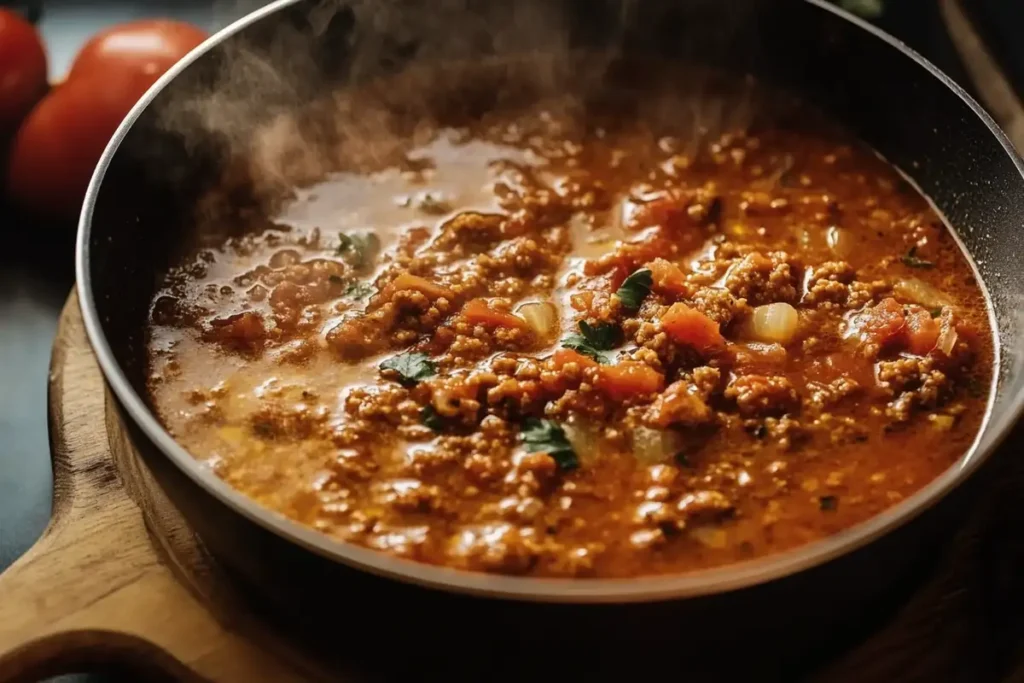
Creating Bolognese sauce from scratch requires patience, but the results are worth it.
Ingredient Selection
The best Bolognese starts with high-quality meat. Ground beef and pork are traditional, but some cooks also include veal. Pancetta or cured pork adds a smoky undertone. For the liquids, red wine and milk provide complexity and balance.
Step-by-Step Cooking Process
- Sofrito Base: Sauté onions, carrots, and celery in olive oil until fragrant.
- Add Meat: Brown the ground meats thoroughly to enhance the flavor.
- Deglaze with Wine: Add red wine and let it reduce, scraping the pan for caramelized bits.
- Add Tomatoes and Milk: Stir in crushed tomatoes and milk, then season with salt, pepper, and a touch of nutmeg.
- Simmer: Let the sauce simmer for 2-3 hours, stirring occasionally for even cooking.
Making a Smooth Bechamel Sauce
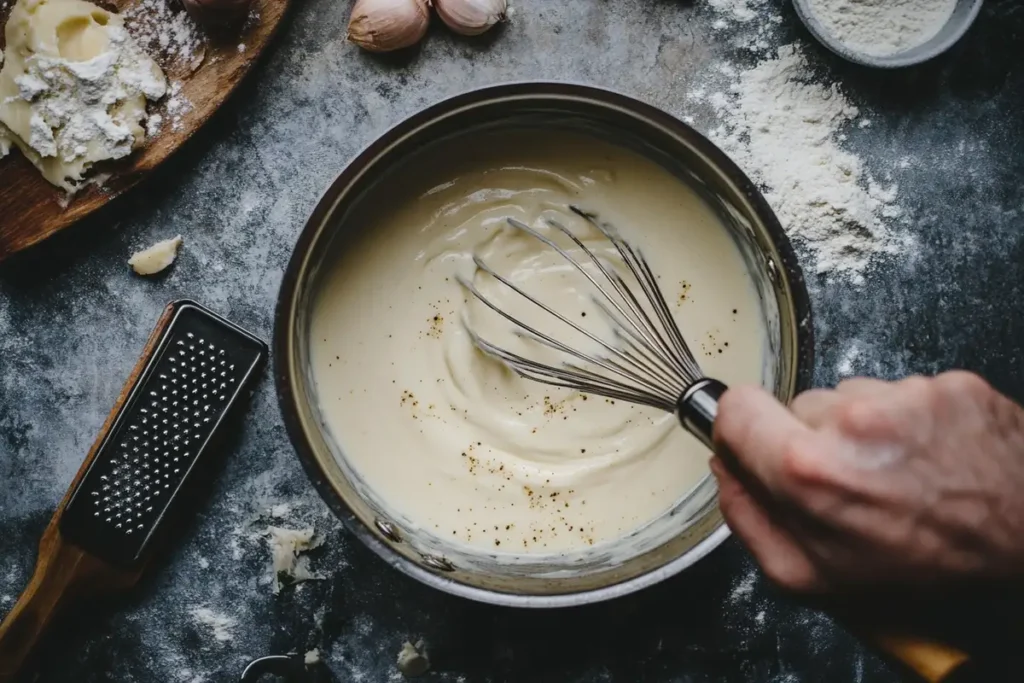
Essential Techniques
Consistency is key when making Bechamel. Start with equal parts butter and flour for the roux. Slowly add warm milk while whisking continuously to avoid lumps.
Flavor Enhancements
While the traditional recipe is simple, you can experiment with garlic-infused milk or add a pinch of cayenne for a mild kick. Whatever you do, don’t skip the nutmeg—it’s a small touch that makes a big difference. The joy of experimenting with these flavor enhancements can add an exciting and adventurous element to your cooking.
Assembling the Lasagna
Choosing the Right Pasta Sheets
The pasta sheets lay the foundation of a perfect lasagna Bolognese with Bechamel sauce. While fresh pasta is the gold standard, dried sheets can also produce excellent results if prepared correctly.
Fresh vs. Dried Pasta
Fresh pasta sheets offer a tender texture that complements the rich sauces beautifully. However, they require more effort, such as rolling and cutting to size. On the other hand, dried pasta sheets are more convenient but must be pre-boiled or layered with extra Bechamel to ensure they soften during baking.
How to Ensure Perfect Layers
If using dried pasta, cook the sheets in boiling salted water for 2-3 minutes before assembling. Fresh sheets can go directly into the dish. To avoid sticking, separate each layer with parchment paper if prepping in advance.
Layering Techniques for Optimal Flavor
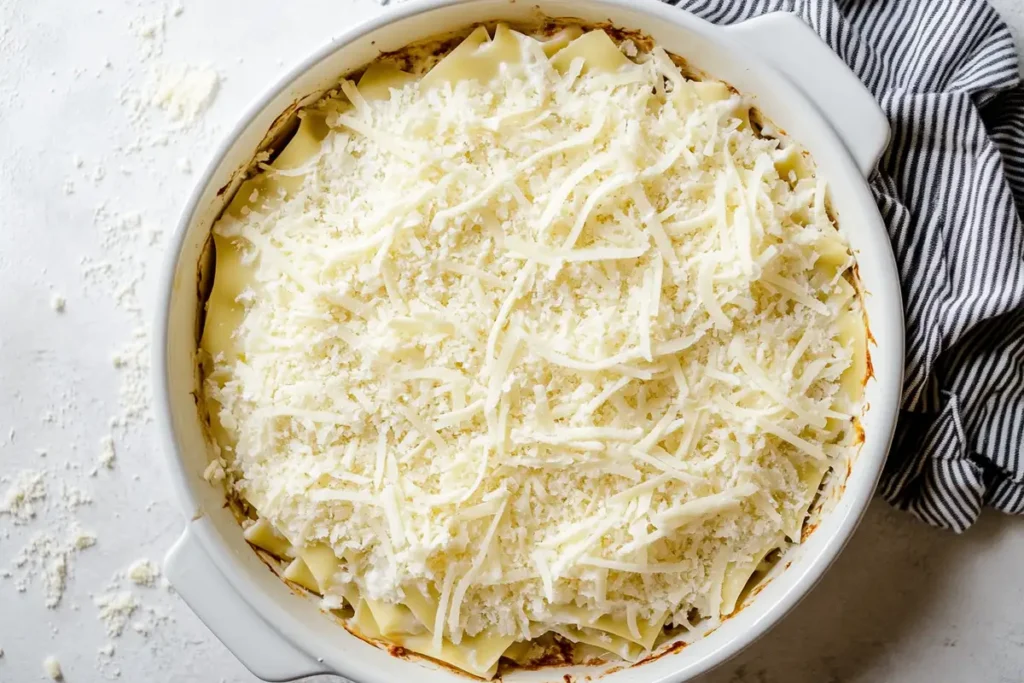
Proper layering is not just a step, it’s an art that is essential to achieving the perfect balance of textures and flavors in your lasagna. Understanding and mastering these layering techniques can make you feel more informed and confident in your cooking.
Sequence of Layers
Begin with a thin layer of Bechamel sauce at the bottom of your baking dish to prevent sticking. Follow with pasta sheets, a layer of Bolognese sauce, a generous drizzle of Bechamel, and a sprinkling of grated Parmesan. Repeat until you reach the top, ending with Bechamel and a final layer of Parmesan for a golden crust.
Achieving the Ideal Thickness
Aim for 5-7 layers for a well-structured lasagna. Too few layers can make it feel sparse, while too many may overwhelm the balance of flavors. Spread each sauce evenly to maintain uniform thickness across the dish.
Baking and Serving The Lasagna Bolognese With Bechamel Sauce
Baking the Lasagna to Perfection
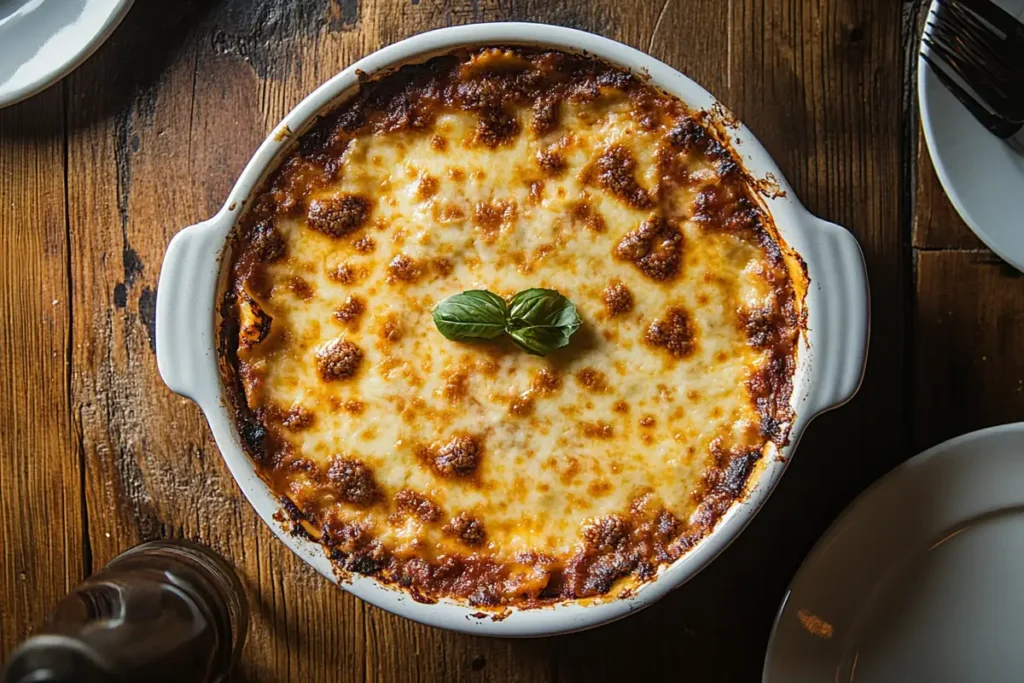
The final step in crafting lasagna Bolognese with Bechamel sauce Recipe is baking it to golden perfection.
Temperature and Timing
Preheat your oven to 375°F (190°C). Cover the lasagna with foil and bake for 25-30 minutes. Remove the foil and bake for 10-15 minutes, allowing the top to brown and the cheese to bubble.
Checking for Doneness
Pierce the lasagna with a knife or skewer—it should slide through easily. The edges should be slightly crispy, and the top should be golden brown. Let the dish rest for at least 10 minutes before serving to let the layers settle, and the flavors meld.
Serving Suggestions
While lasagna is a showstopper, pairing it with the right sides and drinks elevates the dining experience.
Ideal Side Dishes
Serve with a fresh green salad dressed in a tangy vinaigrette to balance the dish’s richness. Garlic bread or a crusty loaf also makes an excellent accompaniment.
Wine Pairings
For a truly Italian experience, pair your lasagna with a full-bodied red wine like Chianti or Barolo. Their robust flavors complement the hearty Bolognese sauce and creamy Bechamel beautifully.
Tips and Variations Of Lasagna Bolognese With Bechamel Sauce Recipe
Common Mistakes to Avoid
Even seasoned cooks can encounter hiccups while making lasagna Bolognese with Bechamel sauce recipe. Avoiding these common pitfalls ensures your dish turns out perfect every time.
Preventing Dryness
Nothing is worse than a dry lasagna! To avoid this, ensure each layer is generously coated with Bechamel and Bolognese sauce. If using dried pasta sheets, don’t skip pre-cooking them or adding extra Bechamel to help them soften during baking.
Ensuring Even Cooking
An unevenly cooked lasagna can ruin the dining experience. Use a baking dish with even depth and size. Rotate the dish halfway through baking to ensure all sides cook evenly, especially if your oven has hot spots.
Variations of Lasagna Bolognese
While the classic recipe is a culinary treasure, experimenting with variations can excite your table.
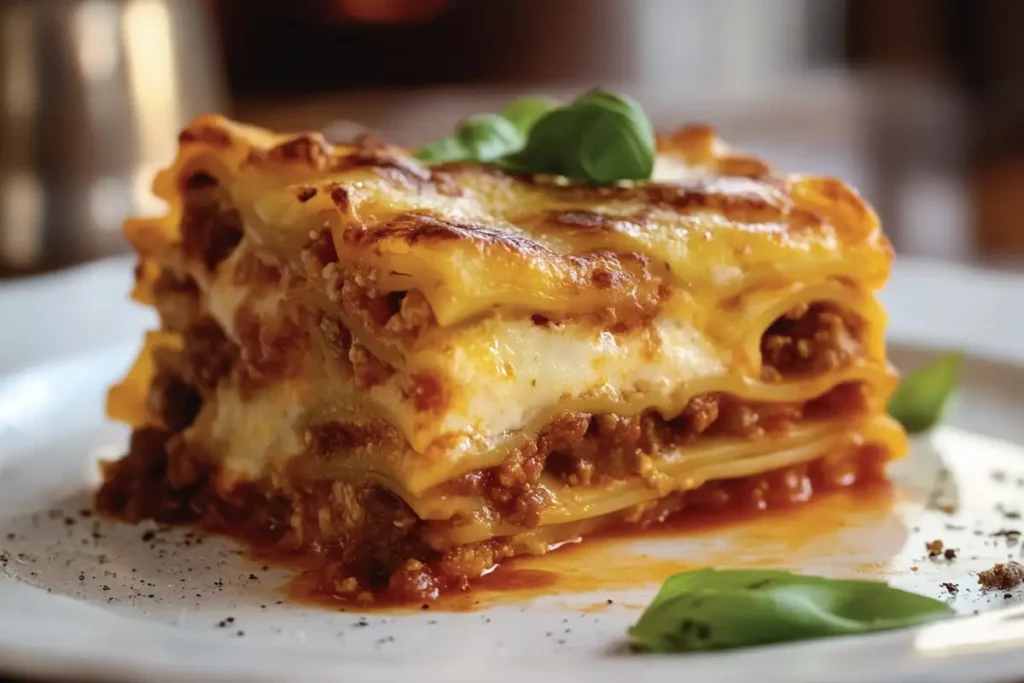
Vegetarian Alternatives
Swap the meat-based Bolognese sauce for a hearty vegetable ragu. Use a mix of mushrooms, zucchini, eggplant, and lentils for depth and texture. The creamy Bechamel will pair just as beautifully with these flavors.
Gluten-Free Options
For gluten-free lasagna, replace traditional pasta sheets with gluten-free versions or thinly sliced zucchini or eggplant. Ensure the Bechamel sauce is thickened with cornstarch or a gluten-free blend instead of regular flour.
Frequently Asked Questions
What is the difference between lasagna sauce and Bolognese sauce?
Lasagna sauce combines Bolognese and Bechamel sauce , which are used in the dish, while Bolognese sauce is a standalone slow-cooked meat sauce. Together, they create the signature richness of lasagna.
Is lasagne white sauce the same as Bechamel sauce?
Yes, lasagne white sauce is just another term for Bechamel sauce. It’s made from butter, flour, and milk and is often seasoned with nutmeg for added flavor.
What part of Italy uses Bechamel in lasagna?
Bechamel is commonly used in lasagna recipes from northern Italy, particularly in Emilia-Romagna, where Bologna is located. It’s a traditional component that gives northern Italian lasagna its creamy texture.
Why do Americans use ricotta instead of Bechamel in lasagna?
Ricotta is often used in American lasagna as a shortcut to replace the more time-consuming Bechamel sauce. It offers a different texture and flavor, reflecting American culinary adaptations of Italian recipes.
Embracing the Tradition of Lasagna Bolognese
The Joy of Homemade Italian Cooking
Making lasagna Bolognese with Bechamel sauce Recipe from scratch is more than just preparing a meal—it’s an immersive experience that connects you to Italian culinary traditions. From slow-cooking the rich Bolognese sauce to perfecting the creamy Bechamel, every step is a labor of love that pays off when you take the first bite.
Homemade lasagna isn’t just food; it’s a centerpiece for family gatherings, celebrations, or cozy nights at home. Each layer reflects your effort and passion, creating a dish that’s as satisfying to make as it is to eat.
A Timeless Recipe Worth Sharing
When you craft a classic lasagna Bolognese with Bechamel sauce, you’re not just following a recipe but preserving a piece of Italian heritage. Whether you stick to tradition or explore creative variations, this dish promises warmth, comfort, and unforgettable flavors.
Ready to get started? Gather your ingredients, pour a glass of wine, and enjoy the journey of creating a masterpiece that’s sure to become a family favorite. Buon appetito!

